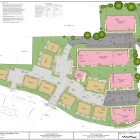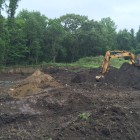Around Town
Town Tradition Fading: Six Years Since New Canaan Had Ice Skating on Mead or Mill Pond
|
It was Dec. 31, 1993, and this thought came to Cam Hutchins as he—3-month-old daughter in his arms, bundled up in a snuggie—followed the sound of a slapshot toward Mead Pond, where dozens of ice skaters wobbled or glided over a frozen sheet of ice, illuminated by parking lot lights and set that New Year’s Eve against a backdrop of Christmas lights: “As she gets older, we can do this.”
“This” being a cherished New Canaan tradition: Ice skating on Mead or Mill Pond. Hutchins, a 1977 New Canaan High School graduate, recalls the fires burning in the Lions Den at Mill Pond during his Center School days. “All winter long, it seemed like we were always going to Mill Pond,” he recalled. “Skating there on the weekends was a big deal.




